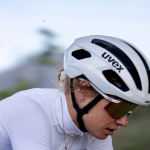Nike, Inc. saw a number of shifts in its business in the fiscal third quarter as Nike brand apparel reversed the downward trend seen in the second quarter in the U.S. and footwear sales got a bigger boost from unit sales growth even as average selling prices started to moderate a bit. Benefits realized from the weaker U.S. dollar contributed a bit to the bottom line and had all other regions outpacing the sales growth seen in the U.S. for brand Nike, as currency exchange rates accounted for approximately three points of the total companys 14% growth in revenues for the period. FX rate benefits also added about 240 basis points to gross margin in Q3 and accounted for roughly $20 million in additional pre-tax income. Gross margin would have actually declined about 40 basis points had it not been for the currency exchange benefits. (see full chart page three)
EPS results bested Wall Street consensus estimates of 99 cents per diluted share. NKE shares dipped 1.4% for the week to close at $85.40 on Friday.
The third quarter conference call with analysts marked the first such call for newly-minted president and CEO Bill Perez. Mr. Perez, who has been with the company for about eight weeks, took the reins from company founder Phil Knight, who made the decision to step away from the day-to-day operations of the company. Perez said he saw even more upside opportunity for Nike, Inc. in the year ahead than he expected. Based on his comments in the call, Perez and the company will clearly focus on growing its portfolio of brands on a global basis. With Starter starting to make some noise at Wal-Mart and Converse converting more of its worldwide distributor network to in-house operations, the market will certainly need to keep a close eye on the “other Brands” section of the companys report each quarter. Perez said that Nike Golf and Cole Haan were also major contributors to the quarters positive results.
Pre-tax income for the “Other Brands”, which includes Converse, NIKE Golf, Bauer NIKE Hockey, Cole Haan, Hurley International, and Exeter Brands Group, increased 724% for the quarter to $23.9 million, as profitability improved in each of the businesses. Any revenue growth due to acquired brands was described as “negligible” for the period.
At brand Nike, the EMEA region, which includes Europe, the Middle East, and Africa, posted sales growth of roughly 9% on a currency-neutral basis. The “most significant” constant dollar revenue gains came from Italy, Central Europe, Turkey, Russia, and the U.K. Italy revenues reportedly increased 25% in constant dollar terms and the U.K. rose 10% for the period. France continues to be problematic as revenues declined there for the period, but new management there and in Germany give the company reason to be positive. Owned-retail revenues also “grew strongly”, reflecting additional outlet stores in the region.
EMEA gross margin improved by 480 basis points, contributing about 150 basis points to the total company GM growth for the third quarter. Management said that beneficial FX rates accounted for the majority of the GM gain, offset a bit by “lower in-line product margins and increased close-out sales in footwear and apparel”. Pre-tax income increased 27.9% to $219.3 million.
For Q4, EMEA revenues are expected to be “essentially flat” as the brand goes up against the energy derived from the Euro 2004 world championship in Portugal last year.
In Asia Pacific, revenues grew 13% on a constant dollar basis, with footwear sales increasing 7%, apparel growing 21%, and equipment increasing 18% in constant dollar terms. China was again the primary driver here, more than doubling revenues versus last year, while revenues in Japan were “slightly below” the prior year quarter when measured in constant dollar terms. Sales did grow when measured in Yen.
Nike brand co-presidents Mark Parker and Charlie Denson both talked about the Japanese market, which looks more like the U.S. market in 2000, as the consumer there either gravitates to the high-end luxe and tech markets or looks for product in the discount category. The middle of the market is the issue and management clearly stated they do not intend to chase the market downward as it gets more promotional. The apparel business, on the other hand, “has never been stronger”.
Asia Pacific gross margin declined 110 basis points, accounting for a 20 basis point hit to total company GM for Q3. The decline was attributed to “lower in-line product margins”. Pre-tax income grew 15.8% to $100.4 million.
For Q4, Nike sees continued double-digit growth coming out of the region.
The Americas region is reportedly on pace for a record year as constant dollar revenues increased roughly 7% for the third quarter. The growth came despite a 7% decline in apparel sales for the period that partially offset a nice 11% constant dollar gain in footwear revenues and a 31% jump in equipment sales. South America continues to be the primary driver as constant dollar sales in Brazil, Argentina, and Chile each grew more than 25% for the period. The gains here were offset by “weaker results” in Canada and Mexico.
Gross margin in the Americas improved 340 basis points in Q3, due primarily to FX rates, lower discounts, and fewer close-out sales; and, pre-tax profit jumped 48.7% to $23.2 million.
Fourth quarter revenues are expected to increase in double-digits in the Americas region.
In the U.S. market, management said that revenue growth was “broad-based” as key athletic specialty, sporting goods, and department stores all “advanced strongly” for the period. Nike owned-retail also gave a boost to the quarter as revenues increased 15% for the quarter and comp store sales at NikeTown stores grew 11% in the period. Footwear revenue growth in the quarter was driven by high-single-digit gains in unit sales on top of continued gains on average selling prices. Nike said sport performance product sales growth outpaced active life product sales gains.
Gross margin improved 20 basis points in Q3, contributing about 10 bps of the total company GM improvement. Footwear margins were flat in the quarter, as higher discount rates generated by more sales to larger customers offset better regular price sell-throughs and fewer close-out sales in the period. The company may be feeling the impact of increased sales to Foot Locker, Inc., which generally commands a higher discount rate than other retailers. For example, the 350 Footaction stores that Foot Locker acquired last year certainly received a lower discount pre-acquisition than the new owners receive. NKE also cited increased product and transportation costs as culprits.
For the fiscal fourth quarter, Nike sees the U.S. business growing in low-single-digits. They see the growth for the current period moderating a bit as they experience a shift in timing of shipments and as non-futures sales such as licensed apparel decline as a percentage of the total business.
Parker said that sell-through of footwear performance product in the U.S. has been as healthy as they have seen them in years. He indicated that average selling prices for footwear futures again trended up. The NBA All-Star Game in Denver and the associated launch of the Jordan XX didnt disappoint either, as the Denver NikeTown store posted its biggest day ever in sales and the XX launch flew out the door.
In addition to a strong commitment to the Nike Pro apparel category, the brand is also focusing on the womens fitness category in a big way. While Nike relied on an integrated marketing campaign on the Pro side to generate energy, they are using more of a grass roots approach to the womens business. Early results from campaigns in the U.S., Europe, and Asia were said to be “impressive” and generated strong sell-throughs. Management pointed to a 20% increase in sales in the combined Nike womens footwear and apparel business in Q3 as evidence they were heading in the right direction.
Demand creation expenditures increased 21% overall, or 17% when measured in constant dollars. The biggest driver here was spending for sports marketing in a number of regions, the womens fitness campaign in Europe, and the development of owned-retail around the world.
Total inventories were up about 1% in constant dollars.
Looking ahead, Nike sees fiscal fourth quarter revenue growth in the mid-single-digit neighborhood, a bit of a moderation from recent quarterly trends. They see Q4 gross margins higher versus Q3, reflecting a “more seasonal pattern.”
For the coming year, and assuming stable FX rates, NKE is forecasting high-single-digit revenue growth and EPS growth in the mid-teens. Fiscal 2006 first quarter revenues are seen increasing in high-single-digits.
>>> Better keep an eye on the “Other Brands”
Could be a $2 billion dollar business next year…















